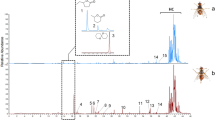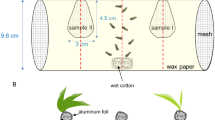Abstract
Selecting a suitable oviposition site is crucial to the fitness of female insects because it determines the successful development of their offspring. During the oviposition process, an insect must use cues from the external environment to make an appropriate choice of where to lay eggs. Generalist insects can detect and react to a plethora of cues, but are under selection pressure to adopt the most reliable ones to override noise and increase efficiency in finding hosts. The oriental fruit fly, Bactrocera dorsalis (Hendel), is a generalist that utilizes a multitude of fruits as oviposition sites. However, the identity and nature of oviposition stimulants for B. dorsalis is not well known. Recently, we identified a volatile compound γ-octalactone that elicits an innate oviposition response in B. dorsalis. We screened 21 EAD-active volatiles, identified from mango, for their oviposition stimulant activity. 1-Octen-3-ol, ethyl tiglate, and benzothiazole instigated oviposition in gravid B. dorsalis females. Flies deposited most of their eggs into pulp discs with oviposition-stimulants, and only a small fraction of eggs were laid into control discs. In a binary choice oviposition assay, 95.1, 93.7, and 65.6 % of eggs were laid in discs treated with 1-octen-3-ol, ethyl tiglate, and benzothiazole, respectively. Single plate two-choice assays proved that oviposition-stimulants were crucial in oviposition site selection by gravid female B. dorsalis. In simulated semi-natural assays, gravid B. dorsalis females accurately differentiated between fruits with and without 1-octen-3-ol, ethyl tiglate, and γ-octalactone by laying more eggs on the treated fruit. However, benzothiazole did not elicit an increase in oviposition when presented in this context. Our results suggest that the identified oviposition-stimulants are ‘key’ compounds, which the flies associate with suitable oviposition sites.



Similar content being viewed by others
References
Aleryan MAS, Ramadan HM, Salem MH (2006) Oviposition stimulants of the peach fruit fly Bactrocera zonata (Saunders) (Diptera: Tephritidae) under laboratory conditions. J Egypt Soc Toxicol 34:1–4
Alyokhin A, Messing RH, Duan JJ (2000) Visual and olfactory stimuli and fruit maturity affect trap captures of oriental fruit flies (Diptera: Tephritidae). J Econ Entomol 93:644–649
Anjum S, Razag M, Yazadni MS (2000) Studies on seasonal activity and control of fruit flies (Dacus spp.) on mango (Mangifera indica) at Faisalabad, Pakistan. Arab J Plant Prot 18:121–123
Bernays EA (1996) Selective attention and host-plant specialization. Entomol Exp Appl 80:125–131
Bruce TJA, Pickett JA (2011) Perception of plant volatile blends by herbivorous insects—finding the right mix. Phytochemistry 72:1605–1611
Bruce TJA, Wadhams LJ, Woodcock CM (2005) Insect host location: a volatile situation. Trends Plant Sci 10:269–274
Campo DM, Miles CI, Schroeder FC, Mueller C, Booker R, Renwick JA (2001) Host recognition by the tobacco hornworm is mediated by a host plant compound. Nature 411:186–189
Clarke AR, Armstrong KF, Carmichael AE, Milne JR, Raghu S, Roderick GK, Yeates DK (2005) Invasive phytophagous pests arising through a recent tropical evolutionary radiation: the Bactrocera dorsalis complex of fruit flies. Annu Rev Entomol 50:293–319
Cornelius ML, Duan JJ, Messing RH (1999) Capture of oriental fruit flies (Diptera: Tephritidae) by protein-baited traps and fruit-mimicking visual traps in a guava orchard. Environ Entomol 28:1140–1144
Cornelius ML, Duan JJ, Messing RH (2000a) Volatile fruit odours as attractants for the oriental fruit fly (Diptera: Tephritidae). J Econ Entomol 93:93–100
Cornelius ML, Nergel L, Duan JJ, Messing RH (2000b) Responses of female oriental fruit flies (Diptera: Tephritidae) to protein and host fruit odours in field cage and open field tests. Environ Entomol 29:14–19
Drew RAI, Raghu S (2002) The fruit fly fauna (Diptera: Tephritidae: Dacinae) of the rainforest habitat of the Western Ghats, India. Raffles Bull Zool 50:327–352
Feeny P, Sachdev K, Rosenberry L, Cater M (1988) Luteolin 7–O–(6″-O-malonyl)-β-d-glucoside and trans-chlorogenic acid: Oviposition stimulants for the black swallowtail butterfly. Phytochemistry 27:3439–3448
Getz WM, Lutz A (1999) A neural network model of general olfactory coding in the insect antennal lobe. Chem Senses 24:351–372
Honda K (1990) Identification of host-plant chemicals stimulating oviposition by swallowtail butterfly, Papilio protenor. J Chem Ecol 16:325–337
Ishtiaq A, Farman U, Alamkhan S (1999) Efficacy of various insecticides and trap heights in methyl eugenol baited traps against fruit flies (Bactrocera spp.). Sarhad J Agric 15:589–594
Kamala Jayanthi PD, Verghese A (2001) A simple and cost-effective mass rearing technique for the tephritid fruit fly, Bactrocera dorsalis (Hendel). Curr Sci 82:266–268
Kamala Jayanthi PD, Woodcock CM, Caulfield J, Birkett MA, Bruce TJA (2012) Isolation and identification of host cues from mango, Mangifera indica, that attract gravid female oriental fruit fly, Bactrocera dorsalis. J Chem Ecol 38:361–369
Kamala Jayanthi PD, Kempraj V, Aurade RM, Ravindra KV, Bakthavatsalam N, Verghese A, Bruce TJA (2014) Oviposition site-selection by Bactrocera dorsalis is mediated through an innate recognition template tuned to γ-octalactone. PLoS ONE 9(1):e85764. doi:10.1371/journal.pone.0085764
Metcalf RL, Metcalf ER (1992) Plant kairomones in insect ecology and control. Chapman and Hall, New York
Metcalf RL, Mitchell WC, Metcalf ER (1983) Olfactory receptors in the melon fly Dacus cucurbitae and the oriental fruit fly Dacus dorsalis. Proc Natl Acad Sci U S A 80:3143–3147
Mwangi MT, Gikonyo NK, Ndiege IO (2008) Repellent properties of delta-octalactone against the tsetse fly, Glossina morsitans morsitans. J Insect Sci 8:1–4
Nishida R (1995) Oviposition stimulants of swallowtail butterflies. In: Scriber JM, Tsubaki Y, Lederhouse RC (eds) Swallowtail butterflies: their ecology and evolutionary biology, 1st edn. Scientific Publishers, Gainesville, pp 17–26
Nishida R, Fukami H (1989) Oviposition stimulants of an Aristolochiaceae-feeding swallowtail butterfly, Atrophaneura alcinous. J Chem Ecol 15:2565–2575
Nishida R, Ohsugi T, Kokubo S, Fukami H (1987) Oviposition stimulants of a citrus-feeding swallowtail butterfly, Papilio xuthus L. Experientia 43:342–344
Noriaki K, Satoshi S, Kyo M, Tokio F (2005) In vitro antifungal and antiviral activities of gamma- and delta-lactone analogs utilized as food flavoring. Biocontrol Sci 10:31–36
Ohsugi T, Nishida R, Fukami H (1991) Multi-component system of oviposition stimulants for a Rutaceae-feeding swallowtail butterfly, Papilioxuthus (Lepidoptera: Papilionidae). Appl Entomol Zool 26:29–40
Okull DO, Beelman RB, Gourama H (2003) Antifungal activity of 10-oxo-trans-8-decenoic acid and 1-octen-3-ol against Penicillium expansum in potato dextrose agar medium. J Food Prot 66:1503–1505
Pandit SS, Chidley HC, Kulkarni RS, Pujari KH, Giri AP, Gupta VS (2009) Cultivar relationships in mango based on fruit volatile profiles. Food Chem 114:363–372
Pinero JC, Mau RFL, Vargas RI (2009) Managing oriental fruit fly, Bactrocera dorsalis (Diptera: Tephritidae), through spinosad-based protein bait sprays and sanitation in papaya orchards in Hawaii. J Econ Entomol 102:1123–1132
Ponnusamy L, Xu N, Nojima S, Wesson DM, Schal C, Apperson CS (2008) Identification of bacteria and bacteria-associated chemical cues that mediate oviposition site preference by Aedes aegypti. Proc Natl Acad Sci U S A 105:9262–9267
Shelly TE (2000) Fecundity of female oriental fruit flies (Diptera: Tephritidae): Effects of methyl eugenol-fed and multiple mates. Ann Entomol Soc Am 93:559–564
Siderhurst M, Jang E (2006) Female-biased attraction of oriental fruit fly, Bactrocera dorsalis (Hendel), to a blend of host fruit volatiles from Terminalia catappa L. J Chem Ecol 32:2513–2524
Stephens AEA, Kriticos DJ, Leriche A (2007) The current and future potential geographical distribution of the oriental fruit fly, Bactrocera dorsalis (Diptera: Tephritidae). Bull Entomol Res 97:369–378
Toloza AC, Zygadlo J, Mougabura CG, Zerba E, Faillaci S, Picollo MI (2006) The fumigant and repellent activity of aliphatic lactones against Pediculus humanuscapitis (Anoplura: Pediculidae). Mem Inst Oswaldo Cruz 101:55–56
Uchida N, Mainen ZF (2007) Odor concentration invariance by chemical ratio coding. Front Syst Neurosci 1:3
Vargas RI, Chang HB (1991) Evaluation of oviposition stimulants for mass production of melon fly, oriental fruit fly, and Mediterranean fruit fly (Diptera: Tephritidae). J Econ Entomol 84:1695–1698
Verghese A, Kamala Jayanthi PD (2001) Integrated pest management in fruits. In: Reddy PP, Verghese A, Krishna Kumar NK (eds) Pest management in horticultural ecosystems, 1st edn. Capital Publishing Company, New Delhi, pp 1–23
Verghese A, Madhura HS, Kamala Jayanthi PD, Stonehouse JM (2002) Fruit flies of economic significance in India with special reference to Bactrocera dorsalis (Hendel). In: Barnes NB (eds) Proceedings of the 6th international Fruit Flies Symposium, Isteg Scientific Publications, Stellenbosch, pp 317–324
Verghese A, Tandon PL, Stonehouse JM (2004) Economic evaluation of the integrated management of the oriental fruit fly, Bactrocera dorsalis (Diptera: Tephritidae) in mango in India. Crop Prot 23:61–63
Verghese A, Uma MS, Kamala Jayanthi PD, Mouly M, Helen M (2011) Evidence of a random ovipositional strategy by female fruit fly Bactrocera dorsalis (Tephritidae: Diptera) with reference to host quantum. Curr Sci 100:25–26
Webster B, Bruce TJA, Pickett JA, Hardie J (2010) Volatiles functioning as host cues in a blend become non-host cues when presented alone to the black bean aphid. Anim Behav 79:451–457
Yuan M, Wang B, Song CB, Rong XL, Yin Y (2008) Effect of climate factors and host plants on population dynamics of Bactrocera dorsalis (Hendel) in Suzhou. J Anhui Agric Sci 22:9619–9621
Zhang D, Li Y, Wu S (2013) Concentration-invariant odor representation in the olfactory system by presynaptic inhibition. Computational Math Methods Med. doi:10.1155/2013/507143
Zhao LJ, Yang XN, Li XY, Wei MU, Liu F (2011) Antifungal, insecticidal and herbicidal properties of volatile components from Paenibacillus polymyxa strain bmp-11. Agric Sci China 10:728–736
Acknowledgments
This work was supported by grant from the Indian Council for Agricultural Research [ICAR]- National Fellow Project awarded to KJPD. We thank the Director, IIHR for providing the required facility for the work. We also thank Rajanna TS and Nagarathna M for their technical help with rearing of insects.
Author information
Authors and Affiliations
Corresponding author
Rights and permissions
About this article
Cite this article
Kamala Jayanthi, P.D., Kempraj, V., Aurade, R.M. et al. Specific Volatile Compounds from Mango Elicit Oviposition in Gravid Bactrocera dorsalis Females. J Chem Ecol 40, 259–266 (2014). https://doi.org/10.1007/s10886-014-0403-7
Received:
Revised:
Accepted:
Published:
Issue Date:
DOI: https://doi.org/10.1007/s10886-014-0403-7




